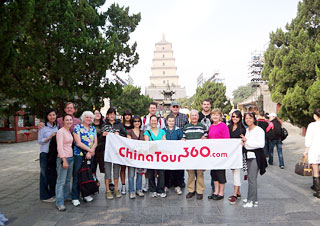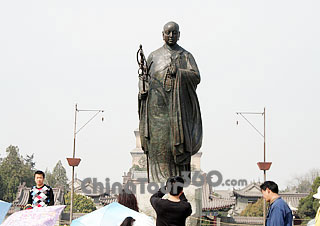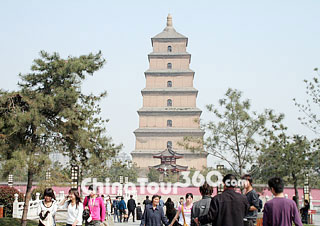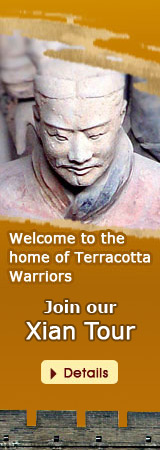 Tour at Big Wild Goose Pagoda
Tour at Big Wild Goose Pagoda Statue of Monk Xuanzang
Statue of Monk Xuanzang Side Scene of Big Wild Goose Pagoda
Side Scene of Big Wild Goose Pagoda
The Big Wild Goose Pagoda is a Buddhist temple situated in the Da Ci'en Temple at the South end of Yanta Road, Yanta District of Xian. Regarded as the symbol of Xian City, it is a must for any travelers to Xian. The panorama of Xian city is available when standing on top of the pagoda.
The Big Wild Goose Pagoda was first built during the reign of Emperor Gaozong of the Tang Dynasty (649 - 683) with five storeys. However, the decay of the pagoda exterior led to the reconstruction of the pagoda to a 10-storeyed one from the year of 701 to 704. Later on, the suffering of massive earthquake and long-time weathering made it incomplete again. It was extensively repaired during the Ming Dynasty (1368 - 1644) and renovated again in 1964. The pagoda currently stands at a height of 64 meters (210 feet).
There are several versions with regard to the derivation of the name of the pagoda. One interesting story is that there are two major sects of Buddhism in India, one is in Mahayana and the other is Hinayana. Master, Xuan Zang, known as Monk Tripitaka, stayed in Mahayana, whose believers are vegetarians and those believe in Hinayana are non-vegetarians. One day a monk from Hinayana bought no meat, and it happened to be the General Alms Day of the Buddha that day. Another monk looked up at the sky and sighed 'The merciful and great Bodhisattva will never forget what day it is today' when a flock of wide geese were flying over his head. Right before he ended his words, the head goose fell into the ground. Thus, all monks were surprised at it. It was their realization that the wild goose was the incarnation of the Bodhisattva. As a result, they set up a stone pagoda where the wild goose fell dead and named it as Wild Goose Pagoda. From then on, they stopped eating meat and believed in Mahayana. The pagoda was modeled after the one in India. It was given the same name in memory of Xuan Zang in praise of Buddhism.
Such a storied pagoda is an architectural miracle. It was built with layers of bricks without any cement in between. The seams between each layer of bricks and the so-called 'prisms' on each side are clearly visible. It was designed and supervised by the first head of the pagoda, Xuan Zang. It was used to keep large amounts of the treasures like Sanskrit Buddhism Classics, and Buddhist relics brought from India. The solemn layout and high structure exemplifies the greatness of the Chinese ancient architecture.
There are two small buildings inside the temple where the pagoda is situated. One houses the iron cast bell on the east side and the other keeps the drum on the west side. Since Ming Dynasty, the 15-tons bell and drum were used to strike time for the monks in the temple.
The three statues in the Great Hall of the Buddha are incarnated Sakyamuni, the founder of Buddhism. The one in the middle is called Dharmakaya who embodies truth and law, the one on the west side is named Bao Shen Buddha, and the other one on the east side is Ying Shen Buddha.
In Tang Dynasty, every successful candidate who passed the imperial examinations would have to climb up the Big Wild Goose Pagoda and left their poems and inscriptions there. Some of the fine portraits in Tang Dynasty are still visible in the stone lintel and doorframes.
The present Ci'en Temple keeps the scale of Ming Dynasty, while the halls are the architecture in the late Qing Dynasty (1644 - 1911). The Wild Goose Pagoda is always a busy and crowded place for worship.
![]() Ticket:
Ticket:
CNY 30 (Mar. 1 to Nov. 30)
CNY 20 (Dec. 1 to the end of Feb. of the next year)
![]() Opening Hours: 09:00 - 17:00
Opening Hours: 09:00 - 17:00
![]() Bus Routes: Take Bus No. 5, 19, 21, 23, 24, 27, 30, 34, 41, 44, 224, 307, 320, 400, 401, 407, 408, 500, 501, 521, 527, 601, 605, 606, 609, 701, 715 or Tourism Bus No. 6 and get off at Big Wild Goose Pagoda, Big Wild Goose Pagoda Southern Square stop, Yanyin Road stop, Yannan Road stop or Yanta West Road stop.
Bus Routes: Take Bus No. 5, 19, 21, 23, 24, 27, 30, 34, 41, 44, 224, 307, 320, 400, 401, 407, 408, 500, 501, 521, 527, 601, 605, 606, 609, 701, 715 or Tourism Bus No. 6 and get off at Big Wild Goose Pagoda, Big Wild Goose Pagoda Southern Square stop, Yanyin Road stop, Yannan Road stop or Yanta West Road stop.








